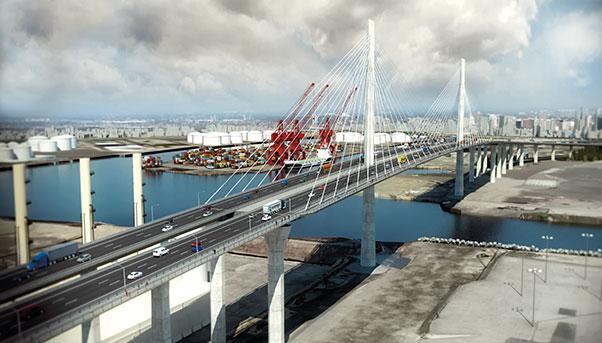The bridge has served its purpose. Half a century after it was built, the old Long Beach bridge is still able to serve the City of Long Beach in southern California but it has come to be called “functionally obsolete” by engineers.
The stress caused by the higher number of cars and trucks that have come to use it as a result of the port’s growing importance to the U.S. economy has taken its toll on the massive structure. In fact, 15% of all imports that arrive to the country as cargo travels across the bridge, which connects the city with Terminal Island where several of the port’s large tenants are located.
Gerald Desmond Bridge: how the reconstruction works began
Named after a former city attorney and councilman, it also has a water clearance that is too low for cargo ships, which have become much larger since 1968 when the bridge opened.
“The current bridge… is in dire need of replacement,” reads official website of the project to replace the bridge.
After public authorities approved financing for the construction of a new bridge in 2010, work by a joint-venture involving Salini Impregilo began three years later.
In December of 2017, workers reached a major milestone with the completion of the project’s two 515–foot–tall (157 metre) towers, creating a bridge that is California’s first cable–stayed bridge for vehicular traffic.
“These new towers …are changing the Long Beach skyline,” said Long Beach Mayor Robert Garcia in a statement at the time. “The bridge is not only an important piece of infrastructure, its design will create a new iconic gateway into our city.”
The new gerald desmond bridge: the completion date and its features
As the main features of the new bridge, the towers will make it the second–tallest cable–stayed bridge in the country once the $1.47–billion project is inaugurated on October 5th 2020.
Another milestone to be reached is the construction of the 2,000-foot-long (610 metre) main span.
With 205 feet (62 metres) of clearance over the waters of the Back Channel — 50 feet (15 metres) higher than the existing span — the new bridge is high enough to allow the latest cargo ships to pass underneath it.
With three lanes in each direction plus safety lanes, it is will be wider and better able to handle the 68,000 vehicles that cross it every day. In a year, it is estimated that about 18 million trips will be made.
The bridge is an important artery in the U.S. trade system. It is designated as a National Highway System Intermodal Connector Route and part of the Federal Strategic Highway Network.
“This bridge will be a lifeline for California’s economy as 40 percent of the nation’s imports come through this complex,” said California Department of Transportation Director Malcolm Dougherty in the statement issued when the two towers were installed in December 2017.
The demolition of the Old Gerald Desmond Bridge
The new bridge was built alongside the old one, which remained open throughout the construction to keep traffic flowing.
After completing the new bridge, the old one was dismantled. The demolition of the old bridge began on July 4th 2018, when several large excavators equipped with jackhammers and grapples began tearing down the elevated access ramp that connected eastbound Ocean Boulevard to the northbound 710 Freeway. The removal of the old connecting ramp allowed the construction of a new ramp.
In Long Beach history, the Gerald Desmond Bridge is not the only structure to have stretched across the Back Channel. The first was a single railroad track built by Salt Lake Railway. By 1908, a bascule drawbridge replaced it. Around the time of World War II, the U.S. Navy installed a pontoon bridge, which served for decades until the erection of the Gerald Desmond.
Opened in 1968, it has followed the economic and industrial development of Long Beach and the rest of the state until the huge volume of vehicular traffic the second–busiest port in the U.S. required the construction of a new bridge.

